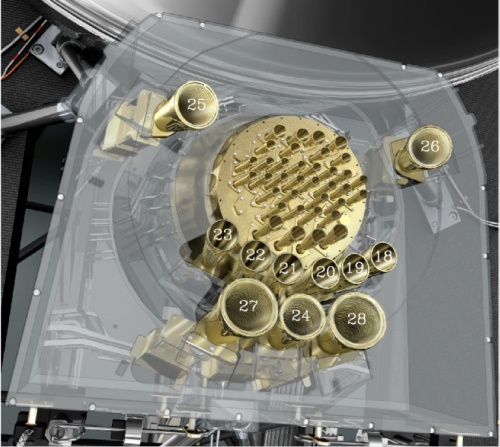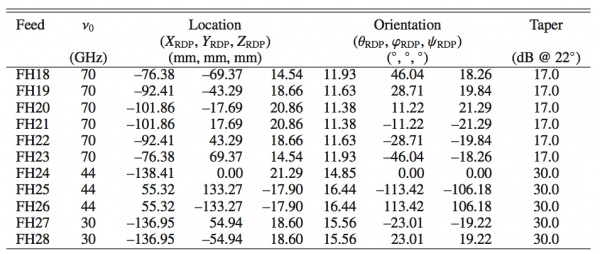Beams LFI
Main Beams and Focal Plane calibration[edit]
In its flight configuration, LFI is coupled to the telescope by eleven dual-profiled, corrugated, conical horns #sandri2010,villa2010: six feed horns at 70 GHz (FH18 – FH23), three feed horns at 44 GHz (FH24 – FH26), and two feed horns at 30 GHz (FH27 and FH28). Figure 1 below shows the arrangement of the horns inside the LFI main frame. It should be noted that the feed position in the focal surface is axisymmetric (for instance, FH27 is symmetric to FH28 at 30 GHz), a natural design choice based on the symmetry of the telescope and satellite. As a consequence, only six different feed elements have been considered in the optimisation analysis: one feed at 30 GHz, two at 44 GHz, and three at 70 GHz #villa2010. The center of the focal surface is occupied by the HFI horns. This optical layout, with one instrument (LFI) around the other (HFI), required that aberration effects in the LFI beams be accurately controlled in the telescope and instrument design optimization phases. Corrugated horns were selected as the most suitable solution in terms of cross polarization levels, sidelobes levels, return and insertion loss. Dual-profiled corrugation shaping was chosen for the control of the main lobe shape, the phase centre location, and compactness. The corrugation profile of each horn was designed to achieve a trade-off between angular resolution and straylight rejection. Each feed horn is connected to an orthomode transducer (OMT) to divide the field propagating into the horn into two orthogonal linear polarization components, X and Y #darcangelo2010a.

The feeds and corresponding OMTs are adjusted in the focal surface so that the main beam polarization directions of the two symmetrically located feed horns in the focal plane unit (FPU) are at an angle of 45 degrees when observed in the same direction in the sky. This configuration permits measurement of the Q and U Stokes parameters and thus the linear polarization of the CMB. The location and orientation of each horn is reported in Table 1, with respect to the reference detector plane (RDP) coordinate system, placed in the center of the FPU and with the ZRDP axis aligned along the chief ray of the telescope.
Once the location and orientation of the feed horns, as well as their inner corrugation profile, had been properly defined, we carried out a full characterisation of the optical performance using electromagnetic simulations devoted to computing the LFI beams. The beam solid angle, Ω, of an antenna is given by
where is the normalized power pattern and the field computed by GRASP is normalised to a total power of 4π watt, i.e.,
For most antennas, the normalized power pattern has consider- ably larger values for a certain range of both θ and φ than for the remaining part of the sphere. This range is called the main beam and the remainder is called the sidelobes or back lobes. Obviously the quality of an antenna as a directional measur- ing device depends on how well the power pattern is concen- trated in the main beam. The received power originating in re- gion outside the main beam is called straylight, and it is one of the major sources of systematic effects in the Planck observa- tions and for CMB experiments in general. In the next section, the sidelobes of the LFI beams are presented, together with the straylight-induced noise evaluated from these beams. The sep- aration of the power pattern into a main beam and sidelobes can be somewhat arbitrary and is basically governed by con- vention. Different definitions of these regions could in princi- ple be used: electromagnetic definitions, science-related defini- tions, and simulation-related definitions. In the framework of the present simulations, the main beam region was defined by tak- ing care that not only the relevant main beam characteristics are computed (angular resolution, ellipticity, directivity, cross polar discrimination factor, and so on), but also that the main beam distortion, at a level of about –60 dB (mainly due to the off-axis location of the LFI feed horns), can be evaluated. This involves longer computational times but ensures a superior knowledge of the systematic effects related to the LFI main beams. The main
Effective beams[edit]
<biblio force=false>
</biblio>
[LFI meaning]: absolute calibration refers to the 0th order calibration for each channel, 1 single number, while the relative calibration refers to the component of the calibration that varies pointing period by pointing period.
(Planck) Low Frequency Instrument
(Planck) High Frequency Instrument
LFI Ortho Module Transducer
European Space Agency
Focal Plane Unit
Cosmic Microwave background
